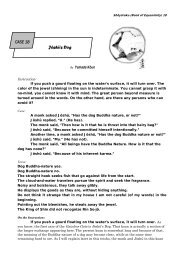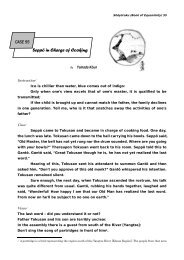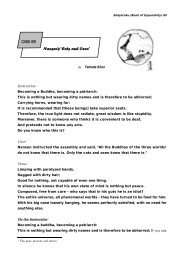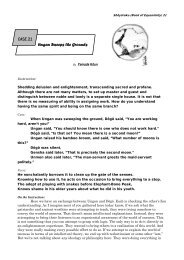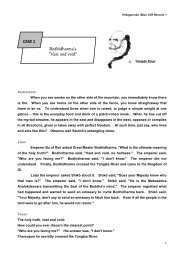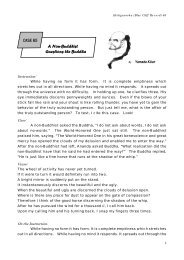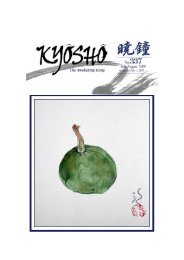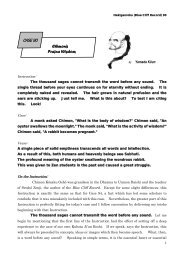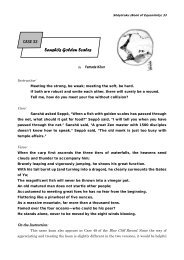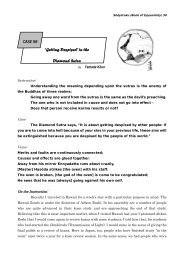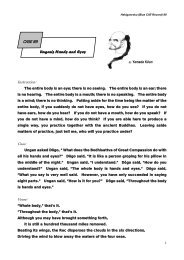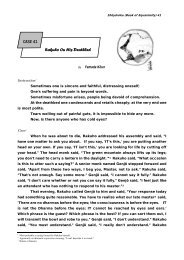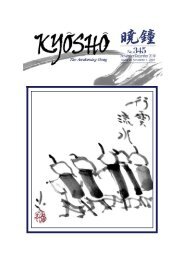Manjusri's "Three Three" CASE 35
Manjusri's "Three Three" CASE 35
Manjusri's "Three Three" CASE 35
You also want an ePaper? Increase the reach of your titles
YUMPU automatically turns print PDFs into web optimized ePapers that Google loves.
Hekiganroku (Blue Cliff Record) <strong>35</strong><br />
<strong>CASE</strong> <strong>35</strong><br />
<strong>Manjusri's</strong> "<strong>Three</strong> <strong>Three</strong>"<br />
By<br />
Yamada Kôun<br />
Instruction:<br />
You establish which is the snake and which the dragon, distinguish stone from jewel,<br />
discern black and white, and settle all hesitancy. If you do not have the frontal eye and if<br />
you don't wear a talisman under your elbow, you'll easily miss a living moment. Right now,<br />
seeing and hearing are unobscured, sounds and colors are clear and true. Tell me, is this<br />
black or is it white? Bent or straight? Having come this far, how do you discern it?<br />
Case:<br />
Manjusri asked Mujaku, "Where have you come from?" Mujaku said, "From the<br />
south." Manjusri said, "How is the Buddhist Dharma in the south maintained?" Mujaku<br />
said, "The monks of this age of the perishing Dharma are venerating the precepts a little."<br />
Manjusri said, "How many monks are over there?" Mujaku said, "<strong>Three</strong> hundred here, five<br />
hundred there." Mujaku asked Manjusri, "How is the Buddhist Dharma maintained here?"<br />
Manjusri said, "Worldly and saints live together, dragons and snakes are mixed with each<br />
other." Mujaku said, "How many monks are here?" Manjusri said, "<strong>Three</strong> three before,<br />
three three after."<br />
Verse:<br />
Thousands of mountains range side by side, majestic blue is their color.<br />
Who says that he spoke with Manjusri?<br />
How ridiculous to ask how many monks on Mt. Seiryô!<br />
<strong>Three</strong> three before, three three after.<br />
Today we meet Bodhisattva Manjusri (Monju Bosatsu). As with all buddhas and<br />
bodhisattvas, in speaking of Bodhisattva Manjusri we refer both to a historical figure and to a<br />
reality of Buddhist Dharma. Bodhisattva Avalokitesvara [Kannon Bosatsu] is also referred to<br />
both as a historical figure and as a symbol of Buddhist doctrine. Thus, on one hand, Manjusri<br />
is the actual person who once lived in India, but on the other hand, that is, from the viewpoint<br />
of Buddhist teaching, he is a symbol of the world of Equality, the world of Mu, expressed as the<br />
1
Hekiganroku (Blue Cliff Record) <strong>35</strong><br />
"Wisdom of Monju."<br />
In our Zendo there is an image of Manjusri seated on a lion at the left of the image of<br />
Shakyamuni who occupies the central position. On Shakyamuni's right is Bodhisattva Fugen.<br />
Manjusri symbolizes the wisdom that penetrates to the ultimate depths of the essential World<br />
as well as that World itself. Fugen represents "compassion" or "ineffable truth" – although<br />
you could also speak about the historical Fugen. The fact that Shakyamuni is seated between<br />
these two bodhisattvas shows that he combines in his personality the two aspects represented<br />
by Manjusri and Fugen. This is apparent in his name as well. "Shakya," translated as Nônin<br />
[ability], points to the power of compassion, just like the figure of Fugen. And "muni,"<br />
rendered as Jakumoku [still silence], is said to mean the wisdom as represented by Manjusri.<br />
Bodhisattva Manjusri appears here and there in Zen literature. We meet him, for<br />
example, in Case 42 of the Gateless Gate: "A Woman Comes Out of Samadhi." In this very<br />
interesting Case, Manjusri comes up as the symbol of the world of Equality. Manjusri is<br />
usually understood to be a layman like many other bodhisattvas – except Bodhisattva Jizô<br />
whose shaven head shows that he is a monk. There seem to be, however, also some images of<br />
Manjusri as a monk.<br />
There are various opinions as to the meaning of Manjusri. Japanese versions –<br />
Manju-suri or Monju-shiri – are transliterated approximations of the original word, hence the<br />
Japanese commonly speak of "Monju Bosatsu." Older translations of the meaning of the name<br />
spoke of "marvellous virtue" or "marvellous intention," while newer versions speak of<br />
"marvellous happiness." But all this doesn't provide any reason for us to call him other than<br />
"Bodhisattva Manjusri."<br />
Although Manjusri is a bodhisattva he is also called "the teacher of the seven<br />
buddhas." Prior to and including Shakyamuni there are seven buddhas. To say that<br />
Manjusri is their teacher refers to the fact that one must penetrate through to the ultimate<br />
depths of the world of Mu in order to attain buddhahood. No one can become a buddha<br />
without clearly realizing the essential World. Because Manjusri symbolizes that world, he is<br />
called "the teacher of the seven buddhas."<br />
Although we venerate the images of Shakyamuni, Bodhisattva Manjusri and<br />
Bodhisattva Fugen in this zendo, the image of Bodhisattva Manjusri is the one that always<br />
occupies the central place in the zendo of a professional Zen monastery. He is called "the holy<br />
monk (seisô)," and the monks in training bow in reverence to him as they enter and leave the<br />
zendo. Manjusri is of the greatest importance in the Zen training hall.<br />
The koan of the present Case consists of a question-and-answer exchange between<br />
Manjusri and another character, Mujaku. Mujaku climbed Mount Godai to engage in a<br />
Dharma exchange with Manjusri. With this background in mind, let's delve into the koan.<br />
On the Instruction:<br />
You establish which is the snake and which the dragon, distinguish stone from jewel,<br />
2
Hekiganroku (Blue Cliff Record) <strong>35</strong><br />
discern black and white, and settle all hesitancy. What does the sentence mean? It refers to<br />
the judgment that a Zen master must make regarding the level of his or her Zen students. It<br />
is of the utmost importance that the master determines whether or not they have attained<br />
realization or where they presently stand in their practice. Therefore, the greatest duty and<br />
responsibility of a Zen master is distinguishing true realization – for example in a sesshin<br />
where the students are likely to present themselves as having attained kensho. If you make a<br />
mistake there, the consequence would be deadly serious.<br />
It frequently happens during a period of intensive practice, such as a sesshin of a week<br />
or so, that some participants work themselves into an emotionally elevated state toward the<br />
end of it. They become excited and, with the help of some active kyôsaku strikes, fall into<br />
what might be called a temporarily abnormal state of mind. There's a real danger of confusing<br />
such a condition with a genuine experience of realization.<br />
In earlier times the Zen students sought constantly to engage masters in Dharma<br />
combats. These days there aren't many opportunities for it. But once this sincere struggle is<br />
no more present, the Dharma is destined to degenerate. The whole thing becomes so easy and<br />
safe, like practicing swimming on dry tatami. Without the serious actuality, your practice<br />
cannot be of any avail when you must face something really critical in your life. In olden times<br />
the Zen student were truly in earnest, so the master was called upon to make a judgment, to<br />
"establish which is the snake and which the dragon, distinguish stone from jewel.” You have<br />
to distinguish whether the student is a great dragon or a simple snake, whether he or she is a<br />
precious jewel or just a polished stone. These days they have refined glass objects, which look<br />
exactly like an authentic jewel. The word pair "black and white" in "discerning black and<br />
white" is an expression commonly used to make a distinction between monks and lay people,<br />
since the monks are usually clothed in black while the lay people don't wear black so much in<br />
their daily life. However, here the expression doesn’t have that connotation; it simply refers to<br />
the qualitative distinction.<br />
"Hesitancy" in "settling all hesitancy" means lingering and delaying – both obstacles to<br />
a decisive conclusion. You hover between two possibilities, without being able to decide which<br />
side you are on. [In the original Chinese text,] one out of the two characters meaning<br />
"hesitancy" [yû in yû-yo] refers to a certain animal supposedly so timid that it runs up a tree<br />
at the least sound or disturbance, where it stays until it makes sure that there is nothing to<br />
worry about; the other character [yo] means "in advance, in precaution." So the word literally<br />
means the animal Yû climbing up the tree by way of precaution. In any case, what's meant<br />
here is that the true master must be able to eliminate hesitancy and bring the student to<br />
decisiveness. As Master Yôka says at the end of his Shôdôka [Song of Enlightenment]: "If<br />
you have still not come to the conclusion, then I will decide it for you!" This is what is<br />
demanded of a true master – although it is no easy matter.<br />
If you do not have the frontal eye and if you don't wear a talisman under your elbow,<br />
you'll easily miss a living moment. The "frontal eye" refers to the "eye" often represented as a<br />
3
Hekiganroku (Blue Cliff Record) <strong>35</strong><br />
vertical eye in the center of the forehead of a Buddha image. It symbolizes the realization of<br />
the world of Equality, of perfect Oneness. In our ordinary "two-eyed" experience, reality<br />
appears to us as divided, as "two." What is really "one" inevitably appears to be "two." How<br />
easy it would be if we could attain kensho simply by getting rid of one eye! The eye in the<br />
forehead of Buddhist images symbolizes the world of perfect Oneness that is realized as the<br />
result of serious practice.<br />
"Wearing a talisman under your elbow" alludes to having a talisman attached<br />
underneath your elbow. It was a custom of ancient Taoist ascetics who engaged in rough,<br />
severe forms of practice. It was said that when they put a certain talisman under their arms<br />
they were capable of manifesting amazing, superhuman powers. True attainment in the<br />
world of Zen means acting as though you had such a talisman on your elbow; otherwise, you<br />
will make a grave mistake. "A living moment" implies that you have to play it by ear. Each<br />
moment in a Dharma exchange is a moment of victory or defeat. You have to decide it on the<br />
spot; if you waver, it will be lost or you will make a fatal mistake.<br />
Let me deviate a bit concerning the "talisman on the elbow." There is a book called<br />
Jimpenki [The Book of Godly Phenomena] which contains anecdotes of the Reverend<br />
Takahashi Yûmyô, a person of supernatural powers. When he used his tremendous spiritual<br />
powers, it is said that a strange lump was formed on his left elbow. Yasutani Haku'un Roshi<br />
mentioned that the "talisman under the elbow" might be connected with that. Well, let it be.<br />
What our text says is that, if you don't reach a similar level, you can't attain truly spiritual<br />
ability.<br />
Right now, seeing and hearing are unobscured, sounds and colors are clear and<br />
true. "Seeing and hearing" without any obscurity means that you can see things rightly and<br />
hear things rightly. "Sounds and colors are clear and true" means that both sounds and colors<br />
are without blemish, pure and true. In actuality, this is something awfully difficult to achieve<br />
and is attained only through assiduous practice. Among the miscellaneous koans given<br />
shortly after the initial kensho is "Thus I hear" (Nyoze-gamon). It's not easy to see and hear<br />
things "thus." As long as our minds are filled with thoughts and concepts, it's impossible to<br />
hear things just as they are. Only when all these have been completely removed can we truly<br />
see and hear things just as they are. "Sounds and colors are clear and true."<br />
Suppose you have come that far. But is that good or not good? Tell me, is this black<br />
or is it white? Bent or straight? Having come this far, how do you discern it? Is this<br />
"white" or "black," that is, authentic or fake? How would you discern it? This is no easy<br />
matter. How could you tell whether it is straight or crooked? Having come to this stage, how<br />
would you fulfill the task of truly judging and discerning a given situation? If you don't know,<br />
look at the following case.<br />
On the Case:<br />
Manjusri asked Mujaku, "Where have you come from?" Mujaku said, "From the<br />
4
Hekiganroku (Blue Cliff Record) <strong>35</strong><br />
south." Historically speaking, Mujaku who appears here is probably Mujaku Monki, a disciple<br />
of Master Hôyû of Mt. Gozu. Master Hôyû himself was the Dharma heir of Master Daii<br />
Dôshin, who was of the fourth generation in the line of succession from Bodhidharma.<br />
In this koan, Mujaku Monki has come to Mt. Godai, which was supposed to be a<br />
training dôjô of Manjusri. Mujaku knew that Manjusri was always pursuing his practice at<br />
that place, so he went to seek him there.<br />
Although Manjusri is usually believed to be at Mt. Godai, this doesn't mean that<br />
Manjusri is always and only there. In fact he may be manifested anywhere. The land of<br />
Manchuria, for example, is said to have received its name because Manjusri – notice the<br />
similarity of the sound – appears there. At least this was asserted in some book.<br />
In any case, Mujaku has come to Mt. Godai to meet Manjusri. On his way up the<br />
mountain, he's come to a barren area without grass or trees. However, there was a temple –<br />
not a real one but a kind of phantom temple that Manjusri has caused to appear (kesa) by some<br />
supernatural power. Upon entering the temple Mujaku finds an old man, who was Manjusri<br />
himself. The following koan is traditionally said to have been the dialogue by the time of this<br />
encounter.<br />
"Monju asked Mujaku, 'Where have you come from?' Mujaku said, 'From the south.'"<br />
Master Engo has some cynical comments to make about this exchange. "In all this vast<br />
expanse of the world," he asks, "where is the 'south'?" Interesting, isn't it?<br />
Manjusri said, "How is the Buddhist Dharma in the south maintained?" Mujaku<br />
said, "The monks of this age of the perishing Dharma are venerating the precepts a little."<br />
The age of the "perishing Dharma" (mappô) means the period where the Buddhist Dharma<br />
degenerates to dust after the age of the "right Dharma" (shôbô) and that of the "semblance<br />
Dharma" (zôbô). So, Mujaku answers, "Yes, these days the Dharma is going down the drain,<br />
but some monks are still upholding the Buddhist precepts and respecting the Dharma."<br />
"Precepts" means the important prohibitions for the Buddhists, as expressed, for example, in<br />
the Ten Great Commandants (Jûjûkinkai). So Mujaku's answer is nothing but a serious,<br />
almost tactlessly serious response. "The monks of this age of the perishing Dharma are<br />
venerating the precepts a little."<br />
Manjusri said, "How many monks are over there?" Mujaku said, "<strong>Three</strong> hundred<br />
here, five hundred there." Master Engo seems to find Mujaku's response almost irritating,<br />
since there is nothing Zen-like in these overly plain and serious answers. He writes, "Let me<br />
answer instead!" Yet Mujaku takes the initiative with his next question.<br />
Mujaku asked Manjusri, "How is the Buddhist Dharma maintained here?" This time<br />
Master Engo highly praises the question, as scoring a nice point.<br />
Manjusri said, "Worldly and saints live together, dragons and snakes are mixed<br />
with each other." Seeing the answer that Manjusri has given to Mujaku, Master Engo<br />
remarks cynically that now even Manjusri has lost his calm! Manjusri is supposed to be the<br />
guardian deity of the world of perfect Equality, and yet he answered, "Worldly and saints live<br />
5
Hekiganroku (Blue Cliff Record) <strong>35</strong><br />
together." But as a koan, <strong>Manjusri's</strong> answer is very important and we do have to work with it:<br />
"The worldly and saints live together, dragons and snakes are mixed with each other."<br />
From the viewpoint of the Buddhist Way, we must recognize that all things are within<br />
the Way: "Within the gates of the Buddhism nothing is to be cast out [Butsuji monchû ippô o<br />
sutezu]." "The worldly and saints live together" – this means: distinguished persons and<br />
ordinary folk, saints and evil-doers, the elderly and children, the sick and the healthy – we're<br />
all together in this universe like passengers on a great ship rolling in the waves as it makes its<br />
way. Monks and novices, company presidents and janitors, the great ones and not-so-great<br />
ones – all are one: "dragons and snakes are mixed with each other." Think of a public bath in<br />
traditional Japan – stripped of everything and all in it together! How's that for "The worldly<br />
and saints live together, dragons and snakes are mixed with each other"! At a public bath<br />
there's at least a distinction between males and females, but reality holds that it would even be<br />
better not to have such a distinction either! Then you can truly say: "The worldly and saints<br />
live together, dragons and snakes are mixed with each other." That's our real world.<br />
Mujaku said, "How many monks are here?" Manjusri said, "<strong>Three</strong> three before,<br />
three three after." This is the problem. Mujaku cannot grasp what Manjusri is saying.<br />
Tradition has it that after answering this last question, Manjusri proceeded to serve tea to<br />
Mujaku. Producing a glass teacup he asked Mujaku, "Do you have this in the south?"<br />
Mujaku, still as serious as ever, answered simply, "No." Manjusri then asked, "What kind of<br />
teacup do you use to drink tea in the south?" Mujaku was unable to reply. This is indeed<br />
insufficient as a Zen reply on the side of Mujaku, isn't it?<br />
After Mujaku bid farewell, Manjusri asked a young boy to see the guest to the gate of<br />
the temple. On the way to the gate Mujaku said to him, "The old man told me, '<strong>Three</strong> three<br />
before, three three after', but how many is that?" The boy then said to Mujaku, "My<br />
Reverend!" Mujaku answered, "Yes." "How many is that?" asked the boy – meaning, "How<br />
many is your 'Yes!'?" Now this is truly Zen-like, isn't it? That's what <strong>Manjusri's</strong> "<strong>Three</strong> three<br />
before, three three after" is about. "My Reverend!" "Yes!" "How many is that 'Yes!'?"<br />
Mujaku asked the boy what the name of the temple was. "It is called Hannya<br />
[=Prajna] Temple," the boy said, and then, pointing at the guardian deity Niô of the temple,<br />
told him, "Look back at the image of the temple guardian." When Mujaku turned to look, he<br />
saw nothing – no temple, no boy, but only a wide empty valley. – This is what Master Engo in<br />
his commentary tells us.<br />
Commentaries from the Zen tradition have not had very much to say about <strong>Manjusri's</strong><br />
"<strong>Three</strong> three before, three three after." My opinion is as follows. Since Manjusri is the<br />
principal figure of the world of perfect Equality, it is evident that he is not dealing with<br />
numbers in the ordinary sense. Rather, "three three in front, three three behind" in the<br />
spatial sense, if you will; or "three three from all ages, three three into the stretches of eternity"<br />
in the dimension of time. In terms of my example of a "fraction," Manjusri is the symbol figure<br />
of that denominator: our essential nature which is both perfectly empty and yet infinitely full<br />
6
Hekiganroku (Blue Cliff Record) <strong>35</strong><br />
of potential. Manjusri cannot but show us that world, and he does so with the word "three<br />
three." So, "three three" is the expression of the world of Essence: "<strong>Three</strong> three before, three<br />
three after."<br />
Were we to relate <strong>Manjusri's</strong> words to Master Tôzan's "Five Degrees of the Particular<br />
and Universal" (henshô-goi ), we might say that they are the degree of "the Universal in the<br />
Particular" (henchû shô). The "particular" (hen) is the phenomenal world, represented here as<br />
"three three," which seems to refer to what we ordinarily understand as numbers; yet, without<br />
our knowing it, this is in fact the essential world (shô) itself. This is what must be examined<br />
in dokusan.<br />
I sit in silence like this. The world that unfolds in front of me is "three three before,"<br />
the world behind is "three three after." The phenomenal world is realized in the world of<br />
absolute nothingness, and this is what <strong>Manjusri's</strong> words "three three" express. His world is<br />
the world of perfect nothingness, but right within it is the world of phenomena. To put it more<br />
pointedly: "<strong>Three</strong> three before" – that's all. It’s the same as Mu! "<strong>Three</strong> three after" – the<br />
same as Mu! It is the perfect presentation of the Essence: "<strong>Three</strong> three before, three three<br />
after." Just as there are waves in the great ocean, you have "three three" in the essential<br />
World as the full manifestation of that world itself.<br />
It's normal for us to think of numbers in terms of a series of positive and negative<br />
integers that extends toward positive and negative mathematical infinity, zero being the center<br />
point. Ordinarily, two numbers such as "one" and "two" are taken to be two concrete numbers.<br />
But since they are taken from that series of infinite integers, they might be understood to<br />
demonstratively represent the entire, infinite series. The "three three" we are faced with here<br />
are not concrete numbers in a series like "three, four, five." The "three three" is to be<br />
understood more in terms of space, and expresses the whole. In short, it is unfolding the world<br />
of Manjusri himself: "<strong>Three</strong> three before, three three after."<br />
On the Verse:<br />
Thousands of mountains range side by side, majestic blue is their color. Mountain<br />
after mountain stretching far into the distance, all of the same indigo color. What is this?<br />
You must look at it very carefully. "<strong>Three</strong> three before, three three after" is re-presented like<br />
this. "Thousands of mountains range side by side, majestic blue is their color." Don't keep<br />
looking at the scenery outside of yourself! You must grasp that the scenery is you yourself<br />
that unfolds in front of you.<br />
Who says that he spoke with Manjusri? How come you can talk with Manjusri?<br />
There is no subject and no object in <strong>Manjusri's</strong> world; it is a world completely void of<br />
dichotomies. What nonsense to say that you talked with Manjusri! – Setchô speaks here with<br />
his ironic humor.<br />
How ridiculous to ask how many monks on Mt. Seiryô! <strong>Three</strong> three before, three<br />
three after. Mt. Seiryô is one of the peaks on Mt. Godai, here used to represent Mt. Godai as a<br />
7
Hekiganroku (Blue Cliff Record) <strong>35</strong><br />
whole. How laughable of Mujaku to ask how many monks are practicing on Mt. Seiryô! Mt.<br />
Seiryô is the world of Manjusri. How can one speak of numbers in <strong>Manjusri's</strong> world? Were<br />
there any "numbers" at all, they would be "<strong>Three</strong> three before, three three after."<br />
This is a difficult koan to swallow. To put it succinctly, "three three," introducing<br />
numbers of the phenomenal world, are in fact the numbers of the essential World. This is<br />
another expression representing the same reality as "Form is emptiness, emptiness is form."<br />
8



